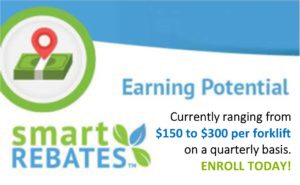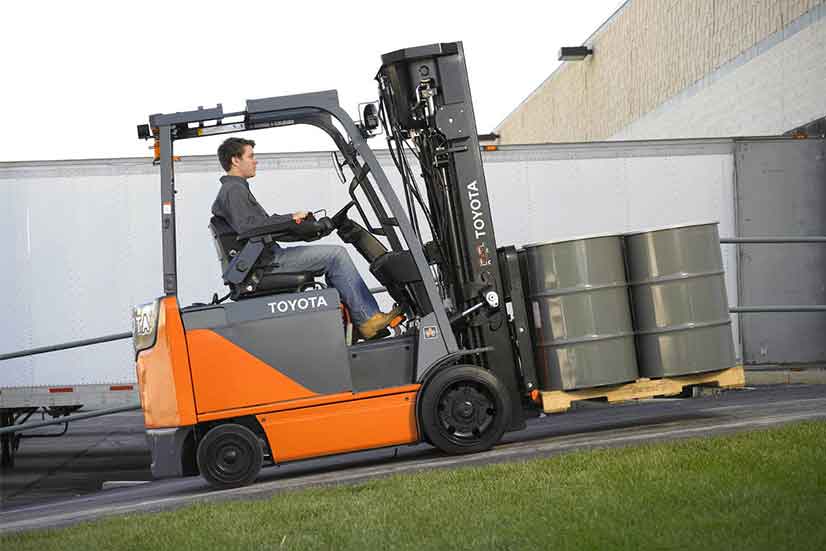As part of California’s efforts to reduce air pollution and greenhouse gases, several programs are available to incentivize California businesses to switch from Internal Combustion to electric equipment. The California Air Resources Board (CARB) recently proposed its plan to phase out all new gas-powered forklift sales by 2026. If you have not heard about it, click here to read answers to frequently asked questions about the proposed upcoming regulations. Here are answers to frequently asked questions about California’s electric equipment incentives.
CALIFORNIA’S INCENTIVES FOR ELECTRIC FORKLIFTS
What are the electric equipment incentive programs available in California?
There are several programs available, including:
- The Carl Moyer Memorial Air Quality Standards Attainment Program
- The Clean Off-Road Equipment Voucher Incentive Project (CORE)
- The California Air Resource Board (CARB) Low Carbon Fuel Standard
What is the Carl Moyer Memorial Air Quality Standards Attainment Program?
Since 1998, the Carl Moyer Program (CMP) has provided funding to encourage the owners of diesel engines to go beyond regulatory requirements by retrofitting, repowering, or replacing their machines with newer and cleaner ones.
The CMP has been a successful and popular air pollution reduction program. While air pollution regulations remain the primary means to reduce emissions, the CMP complements California’s regulatory program by providing incentives for early or extra NOx, PM, and ROG emission reductions.
Click here for more information on the CMP related to port equipment.
What is The Clean Off-Road Equipment Voucher Incentive Project (CORE)?
The Clean Off-Road Equipment Voucher Incentive Project (CORE) is a $125 million project intended to encourage California off-road equipment users to purchase or lease currently commercialized zero-emission off-road equipment.
This streamlined voucher incentive project helps offset the higher cost of zero-emission technology with a point-of-sale discount. There is no scrappage requirement, and additional funding is available for charging and fueling infrastructure and equipment deployed in disadvantaged communities.
Lonestar electric terminal tractors are eligible for CORE vouchers.
CARB’S CASH INCENTIVES FOR ELECTRIC FORKLIFTS
What is the CARB Low Carbon Fuel Standard?
CARB’s Low Carbon Fuel Standard offers zero-emission electric equipment owners cash incentives.
Who is eligible for CARB’s cash incentives?
Zero-emission electric equipment owners in California.
What type of material handling equipment is eligible for CARB’s cash incentives?
The following material handling equipment is eligible for CARB’s cash incentives:
- Electric forklifts
- Electric pallet jacks
- Electric order pickers
- Electric walkie riders
- Electric reach stackers
- Yard Truck
Is there an uncomplicated way to sign up for CARB’s Low Carbon Fuel Standard?
Yes! Our partner, Smart Charging Technologies (SCT), can handle everything for you with their Smart Rebates Program.
CALIFORNIA’S SMART REBATE PROGRAM FOR ELECTRIC FORKLIFTS
What is the Smart Rebates Program? 
The Smart Rebates™ program is an energy rebate program managed by our partner, SCT that allows Toyota Material Handling Solutions (TMHS) client companies to receive rebates from the California Air Resources Board (CARB) through the Low Carbon Fuel Standard (LCFS).
Why should we work with SCT to receive rebates?
To alleviate the complexity of navigating the CARB and LCFS program, SCT will administer and manage these rebates on behalf of TMHS client companies while allowing its customers to receive steady revenue from the LCFS program. LCFS revenue streams fully cover SCT services with no out-of-pocket costs to TMHS customers.
How much can you earn in the Smart Rebates Program?
As a participant in the program, your company will receive quarterly payments based on the electricity used by forklifts and other material handling equipment (MHE). Typical earnings vary depending on the type of equipment and usage and can range from $150 to $300 (or even more) per forklift per quarter for as long as your company remains enrolled and qualifies for LCFS credits.
How often do you get paid? 
Companies in the program get paid quarterly for switching to electric forklifts. Payments are typically paid out within three months after the end of the reporting quarter. Note that electricity usage, and subsequent earnings, can vary due to several factors such as equipment mix (class 1, 2, or 3 trucks), load weights and lifting heights, duty cycle, battery charger efficiency, and business seasonality.
What type of information do we need to share with SCT?
An environmental attribute comes from each kWh of electricity used in your forklift trucks and other electric or alternative-fueled vehicles and equipment. TMHS customers must opt-in and permit Smart Charging Technologies to manage their environmental attributes. Smart Charging Technologies will then sell the environmental attributes every quarter to create revenue for the companies that enroll and opt-in to Smart Charging Technologies Smart Rebates Program.
What is the process for enrolling in Smart Rebates?
- Contact TMHS to get started
- Smart Charging Technologies (SCT) will contact you to perform a site audit
- SCT will estimate projected LCFS/CFP credits
- The customer enrolls in the SCT Smart Rebates™ program
- SCT calculates and files quarterly reports
- SCT aggregates credits and brokers/sells credits
- SCT distributes cash rebates to customers
If you’re ready to start, click here to request an Incentive Estimate for the Smart Rebates Program.
Where can we find information on other programs available to California business owners?
The Funding you’re Tool helps stakeholders search and filter for Medium-and-Heavy-Duty Alternative Fuel Vehicle and infrastructure programs in California.
Start by filtering results by ZIP Code, then filter based on the other criteria you desire. Please note that for the most accurate and up-to-date information about each program, you should visit the website and speak with the agency directly.
Click here to visit the Funding Finder Tool.

